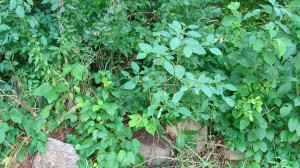I spent the past week in Connecticut. Not the part that feels a little like New York City, but the rural part with real colonial houses, ferries across rivers, and village greens. Throughout New Englandthere are stone walls built by the original settlers. These old walls run along the roads, through fields and even in the middle of the woods. At the base of many of the walls is a host of poison ivy, just waiting to give some unsuspecting wanderer a blistery, itchy rash. Interestingly, a tallish leafy plant called jewel weed is usually found growing right beside the poison ivy. Jewel weed can act as an antidote to poison ivy–it’s used for red, moist, and itchy rashes.
Jewel weed and poison ivy are considered to be companion plants that tend to grow together, in which one plant is the offender (in this case, poison ivy) and the other is the antidote…uh, the jewel weed. Similarly, if you wander into a  patch of stinging nettles, you can usually find the antidote, dock, growing nearby–another example of companion plants growing side-by-side.
patch of stinging nettles, you can usually find the antidote, dock, growing nearby–another example of companion plants growing side-by-side.
So why am I writing about companion plants in a post about acupuncture and Chinese medicine? Well, for a couple of reasons. First, the use of herbs is an important component of Chinese medicine. Typically, herbs are combined in formulas because they can potentiate (make stronger), balance, or offset the actions of other herbs. Companion herbs growing in the Connecticut countryside are an example of one herb offsetting the effects of another.
Second, I began this post with the intention of shedding a little light on the treatment of rashes using Chinese medicine. In general, the appearance and qualities of a rash give a practitioner a pretty good idea of what’s going on and how best to treat it. For example, a poison ivy rash tends to begin with blisters which become red and very itchy. That tells me that the rash has a damp quality to it (the blisters) combined with heat (the red color) and something called wind. Wind is a pathogen that’s characterized by itching, movement where there should be none, and symptoms that come and go. If a rash is itchy, there is some element of wind involved.
The qualities of your rash often mirror what it also going on in your body. Here are a few diagnostic clues:
Color. If your rash is extremely red, there is heat involved, and a practitioner would use acupuncture or herbs to clear the heat in the rash, but also in your body. If a rash is white or colorless, there is no heat, and it may actually have a cold element to it, in which case, warming would be the appropriate action.
Moisture. Rashes with blisters, pustules, and other gross wet stuff are considered to be damp. Treatment would therefore target the dampness through drying, draining, or helping your body to absorb it in some way (resolving). A rash that’s dry and flaky is an indication that there is some depletion of moisture, obviously in the rash, but also in your body. Acupuncture, herbs, and food are particularly helpful in this case.
Itchiness. As mentioned above, if your rash is itchy, there is some wind involved, most likely just on the surface of your body. There are some acupuncture points that are very good for itching, and a topical herbal formula may be really helpful, too. In addition, rashes that come and go, such as hives, are also considered to have wind–both because they itch, but also because they appear, disappear, and then show up someplace else.
So if you’re wandering in the New England countryside and just happen to brush up against some poison ivy, you have a couple of options. You can notice that the rash has a damp warm and windy quality to it and consult with your practitioner of Chinese medicine. Or, you can pick a little bit of jewel weed, crush it up and rub it on the rash. It clears heat, resolves damp, and helps relieve the itch.



